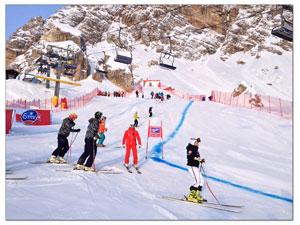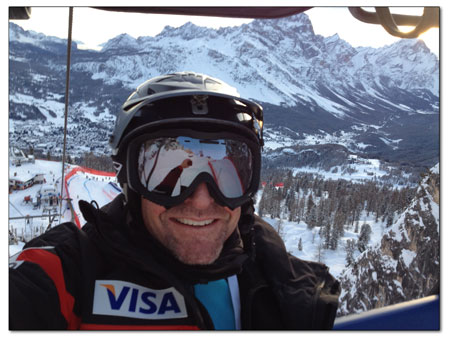|
|
| Dr. Patrick McLaughlin, of Animas Spine, takes a selfie during his recent stint as team doc for the U.S. Womens Ski Team in Cortina, Italy. McLaughlin found out about the volunteer position during his fellowship at the prestigious Steadman Hawkins Clinic in Vail. McLaughlin specializes in injury prevention and rehabilitation using the cutting-edge platelet rich plasma (or PRP) therapy. /Photo by Patrick McLaughlin |
Going for the gold
Olympic Ski Team doc gets taste of life in the fast lane
by Page Buono
The road to Olympic glory can be long, twisted and bumpy – not just for athletes but for the people tasked with keeping their bodies humming like the finely tuned machines they are.
Just ask Durango doctor Patrick McLaughlin, a partner at Animas Spine, who recently returned from a stint in Cortina, Italy, where he served as the U.S. Women’s Ski Team physician. He worked with the women’s Olympic downhill and Super G team, including Julie Mancuso, who took a bronze in this year’s super-combined. And, like many of the athletes McLaughlin works with, his path required determination and a little creativity.
McLaughlin came late to the medical profession, at least by normal standards, though he never doubted his arrival in the field. A soccer player at UCLA, McLaughlin didn’t turn his interest toward school until his eligibility ran out and the resulting 2.75 GPA didn’t appeal to medical programs.
So, he sought experience instead. After a stint volunteering with disabled skiers in Bozeman, Mont., he accepted a job instructing disabled skiers at Bear Creek in California, using his EMT certification to work at hospitals in the summer.
In those years, he was looking for perspective on life, and the individuals he worked with offered exactly that: the girl with paralyzed ankles who insists on snowboarding, succeeds, and then pokes fun at struggling skiers; the young girl with flesh-eating bacteria whose biggest wish was a day on the hill with her friends; or the boy who skied with an amputated leg, crashed and then made everyone hide in the bushes so he could use the prosthetic appendage as a hoax until the sled came.
“They taught me a lot of appreciation for life, and how to maintain a sense of humor,” McLaughlin said. “They’ll teach you never to give up.”
And, he didn’t.
Feeling the pull of medical school, McLaughlin applied and was rejected. But he didn’t stop there – he prodded them, asking what he could do to get in. Administrators told him he could go ahead and take the classes without being enrolled in the program. And, if he did well, they hinted they would have a hard time rejecting him again.
“I’m all about going through the back door,” he said.
So, he did well in a couple classes, applied again and was accepted.
McLaughlin believes his age – 34 when he was accepted – gave him an advantage over younger, more “traditional” students.
“When I turned 30 I was like, ‘I don’t care what anybody thinks anymore,’” he said. The confidence that comes with age allowed him to stay true to his personal philosophies in an often intimidating environment.
 |
|
The scene at the training course in Cortina. As team doctor, McLaughlin was required to attend all athlete trainings, including dry land and gym sessions. While he’s trained to deal with everything, from medical emergencies to bumps, bruises and colds, often his biggest role is as an advocate for the athletes’ care./Photo by Patrick McLaughlin |
“One attendee asked me, ‘Where did you learn to talk to patients?’” to which he responded, “waiting tables.”
He graduated from the University of Colorado School of Medicine, Denver, where he majored in physical medicine and rehabilitation, focusing on musculoskeletal injury prevention.
McLaughlin moved on to complete his residency at the University of Utah. Tasked with three talks during the course of his residency, he spoke on unconventional topics such as medicine and spirituality, acupuncture, and something called platelet rich plasma (PRP) therapy.
The latter is a new technology used in the healing and rejuvenation of ligaments, tendons and joints, such as shoulders and knees. According to McLaughlin, tests show this therapy to be as effective as steroids without the side effects.
“It’s your own stuff, and it’s regenerative instead of degenerative, and people don’t react to it,” he said. “Anywhere you can put steroids, you can use PRP.” 4
McLaughlin pursued a fellowship in the technique at the prestigious Steadman Hawkins Clinic in Vail under Dr. David Karli, whom he had worked with during his schooling in Denver. It was there that he jumped at the chance to volunteer for the United States Ski Association physician pool. These volunteer physicians are present at most events where Olympic skiers compete.
In addition to completing the required Medical Emergencies in Skiing and Snowboarding course (MESS), volunteer physicians must also commit to traveling with the team once every three years. Additionally, McLaughlin had to pass a preliminary “test,” traveling with the team and getting the primary team doctor’s and trainers’ feedback about how he did.
His first trip with Olympic athletes was Finland in November 2010. Working with athletes like Lindsey Vonn and Bode Miller, he was required to be at every training session. “Because it was a men’s and women’s event, there was someone basically on the hill all day every day,” he said.
Hanging out with the team and accompanying them to dry land and gym sessions made McLaughlin nostalgic for his days as an athlete at UCLA.
“I was really nervous about the first time I went,” McLaughlin said. “Then I found out it was just a slalom race and I felt a lot better.” Since then, McLaughlin has served at a NorAm mogul ski race in Telluride, where several Olympic athletes were racing, and, most recently, at the Olympic downhill training in Italy.
Fortunately, McLaughlin said, he doesn’t have to deal with a lot of injuries because the athletes are in such exceptional shape. And, while he’s trained to deal with everything from major medical emergencies to bumps, bruises and colds, he said often his biggest role is as an advocate for the athletes’ care, and to serve as another medical professional on the ground.
While he didn’t often have to treat athletes, when he did, it could be a bit of a challenge. “One of the hardest things is limitations on medications,” McLaughlin said. “Because they’re part of the World Anti-Doping Agency, it puts a lot of constraints on things you might normally do.”
Some things that he has to work around are restrictions on steroids, cold medications, anything that has too much caffeine, and pain medications.
“It takes a lot to get permission for an exception, and there’s rarely time,” McLaughlin said.
As a result, a lot of treatment employs methods like massage, dry needle, cupping and anti- inflammatory medications.
Additionally, McLaughlin said most athletes have some sort of chronic injury they’re dealing with – most commonly back injuries due to compression.
“It was definitely beneficial having an athletic background,” he said. “You know sort of what level they might be willing to put up with pain-wise.”
In that sense, being an Olympic physician means practicing functional medicine.
“Athlete safety is number one, so you are trying to make a diagnosis, but it’s an on-the-spot diagnosis. There’s not time to say ‘OK, come back in a week and we’ll see how you’re doing.’”
McLaughlin said the financial burden of paying his way will probably keep him from accompanying a team next year, but he’s still riding high from this year’s experience.
“It’s been fun because I’ve been emailing back and forth with their trainer, and she sent me a picture of Julia with her medal.” He said. “It’s a lot of fun.”

